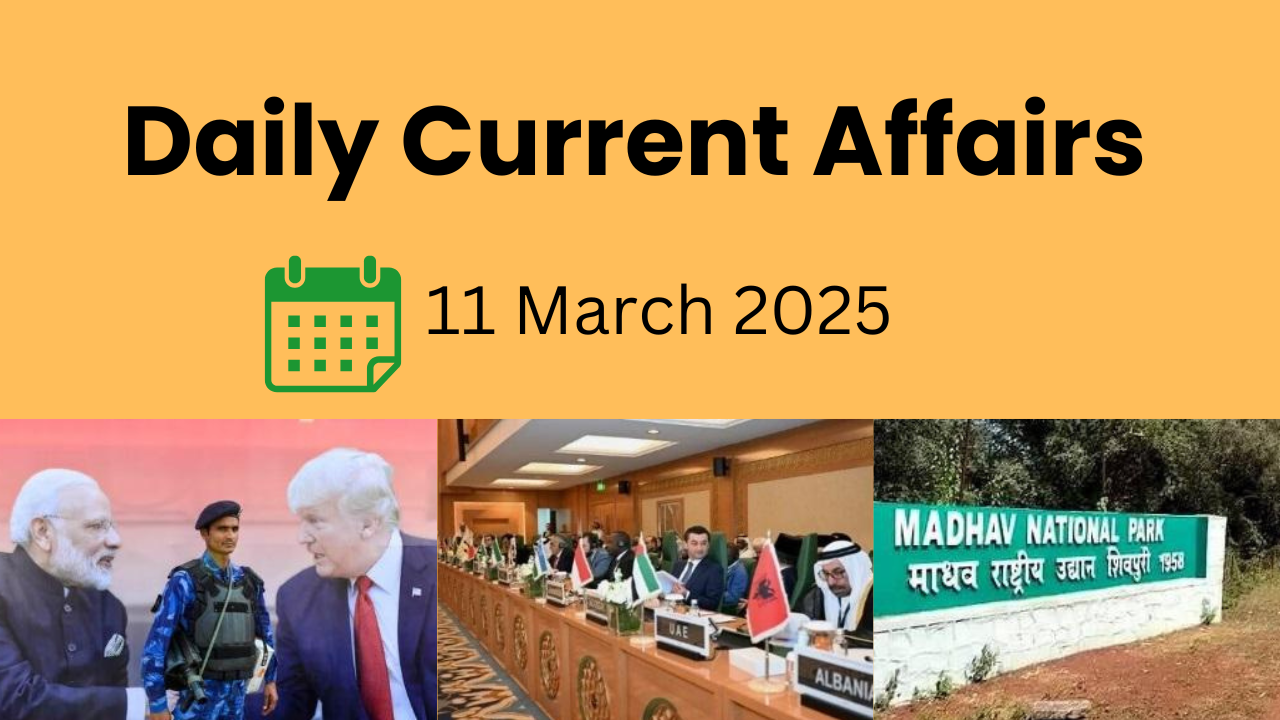1. India Expands U.S. Oil & LNG Imports, Strengthening Energy Partnership
Context: India is set to significantly increase crude oil and liquefied natural gas (LNG) imports from the U.S., reinforcing energy cooperation between the two nations. This decision follows discussions between Prime Minister Narendra Modi and President Donald Trump, aiming to strengthen energy security and expand trade relations.
According to a Reuters report, U.S. crude oil exports to India reached 357,000 barrels per day (bpd) in February, a sharp increase from 221,000 bpd last year.
India’s Commitment to U.S. Energy Imports:
As the world’s third-largest oil consumer, India is heavily dependent on imports, fulfilling 85% of its crude oil needs through foreign sources. Expanding U.S. energy imports serves multiple objectives:
- Enhancing Energy Security: Reducing reliance on a single region for crude oil.
- Boosting Bilateral Trade: Contributing to the goal of doubling U.S.-India trade to $500 billion in the next five years.
- Diversifying Energy Supply: Strengthening resilience against price fluctuations and geopolitical risks.
Currently, trade between the two nations favors India, with a $45.7 billion trade surplus in 2024, marking a 5.4% increase from 2023.
Expanding U.S. Energy Supply to India:
India is actively working to establish the United States as a key supplier of crude oil, petroleum products, and LNG. The partnership also includes:
- Increased hydrocarbon trade covering crude oil, petroleum products, and ethane.
- Growing investments in oil and gas infrastructure.
- Stronger collaboration between energy companies from both countries.
Additionally, discussions have included civil nuclear energy cooperation and U.S. support for India’s full membership in the International Energy Agency (IEA).
India’s Soaring Oil & Gas Demand:
In the 2023-24 financial year, India imported 234.26 million tonnes of crude oil, with import dependence rising to 87.8%. Meanwhile, domestic production remained stagnant at 29.36 million tonnes, meeting less than 13% of total demand.
- Despite stable import volumes, India’s crude oil import bill fell to $133.37 billion, down from $157.53 billion in 2022-23, due to lower global oil prices.
- India spent $22.93 billion on petroleum imports, including LPG and fuel oil.
- The country imported 31.80 billion cubic meters (bcm) of LNG, an increase from 26.30 bcm in the previous fiscal year.
Strategic Push for Natural Gas & Clean Energy:
India aims to increase natural gas consumption from 6% to 15% of its energy mix, making LNG imports crucial for its energy transition. This aligns with U.S. interests in securing long-term LNG buyers, especially if European demand shifts away from American gas in the future.
India’s Diversified Energy Strategy:
While India is strengthening its energy ties with the U.S., it continues to diversify its oil suppliers, engaging with Brazil, Argentina, Suriname, Canada, and Guyana.
Russia’s Growing Role in India’s Energy Market:
Since the Ukraine war, India has significantly increased Russian crude oil imports, benefiting from discounted prices amid G7-imposed sanctions.
- India purchased €49 billion worth of Russian crude in the third year of the conflict.
- Russian oil now accounts for 40% of India’s total crude imports, compared to less than 1% before the war.
Despite this shift, India maintains a balanced approach, ensuring energy security while exploring better pricing options.
India’s Rising LNG Demand & Supply Challenges:
India’s natural gas demand is projected to reach 103 billion cubic meters (bcm) annually by 2030. The demand has surged over 10% annually in both 2023 and 2024, signaling a new growth phase.
Challenges & Key Growth Drivers:
- Domestic production met only 50% of gas demand in 2023, though it’s expected to rise to 38 bcm by 2030.
- Three key factors drive India’s gas market transformation:
- Rapid infrastructure expansion in LNG terminals and pipelines.
- Recovering domestic production, reducing supply constraints.
- Global LNG market stabilization, improving affordability.
To stay competitive in a price-sensitive energy market, India is focusing on long-term contracts, supply diversification, and strategic planning.
Conclusion: India’s Path to Energy Security:
India is actively working to reduce its energy import dependency through multiple strategies:
- Expanding clean energy initiatives, including ethanol, compressed biogas, and biodiesel.
- Investing in electric vehicle (EV) charging infrastructure to reduce reliance on fossil fuels.
- Securing long-term LNG partnerships, particularly with the U.S.
By balancing global energy partnerships, increasing domestic production, and investing in alternative fuels, India is shaping a resilient and sustainable energy future.
2. India Backs Mauritius’ Sovereignty Over Chagos Archipelago Key Highlights
Context: During his visit to Mauritius, Prime Minister Narendra Modi will strengthen India’s diplomatic, economic, and strategic ties with the island nation.
Ahead of the visit, Foreign Secretary Vikram Misri reiterated India’s full support for Mauritius’ sovereignty over the Chagos Archipelago. This aligns with India’s consistent stand on decolonization, emphasizing the need for historical injustices to be corrected.
Chagos Archipelago: A Historical Overview:
The Chagos Archipelago is a chain of over 60 islands in the Indian Ocean, located about 500 km south of the Maldives. It forms the southernmost part of the Chagos-Laccadive Ridge, an underwater mountain range.
Colonial History of Chagos::
- 1715-1810: Controlled by France as part of its Indian Ocean territories.
- 1814: France ceded the islands to the UK under the Treaty of Paris.
- 1965: The UK separated Chagos from Mauritius—three years before granting Mauritius independence—to form the British Indian Ocean Territory (BIOT).
- 1970s-Present: Diego Garcia, the largest island, was leased to the U.S. and UK for a joint military base, which remains operational.
The forced displacement of Chagos’ native population and continued British control have been long-standing points of contention.
Negotiations Over Chagos Sovereignty:
Mauritius and the UK have been engaged in prolonged negotiations over the sovereignty of Chagos.
- The UK and U.S. have reached a political agreement to maintain Diego Garcia as a strategic military base, while returning the remaining Chagos islands to Mauritius.
- On October 3, 2024, the UK announced that a treaty was being drafted to formalize this arrangement.
India’s strong backing of Mauritius in this dispute underscores its support for international law and post-colonial justice.
India-Mauritius Relations: A Strong and Historic Bond:
India and Mauritius share deep-rooted ties, shaped by history, culture, and economic cooperation.
- 70% of Mauritius’ population is of Indian origin, making India a natural ally.
- Mauritius was among the first countries with which India established diplomatic ties in 1948, even before Mauritius gained independence in 1968.
- Both nations enjoy robust cooperation in maritime security, trade, capacity building, and cultural exchanges.
Key Aspects of India-Mauritius Ties:
- First Responder in Crises – India has always supported Mauritius, including during the COVID-19 pandemic and Wakashio oil spill disaster.
- Major FDI Partner – Mauritius has invested $175 billion into India since 2000, accounting for 25% of India’s total foreign direct investment (FDI) inflows.
- Strategic Trade Agreement – The Comprehensive Economic Cooperation and Partnership Agreement (CECPA), signed in 2021, was India’s first trade deal with an African country.
Significance of PM Modi’s Visit to Mauritius:
PM Modi’s visit to Mauritius in March 2025 carries major strategic importance:
- Mauritius is a key maritime partner in the Indian Ocean region.
- Indian Air Force contingents and an Indian Navy ship will participate in the National Day celebrations.
Several bilateral agreements are expected to be signed, further boosting trade, security, and development cooperation.
- This marks PM Modi’s return to Mauritius after a decade, following his last visit in 2015.
Conclusion: Strengthening India-Mauritius Ties & Supporting Decolonization
PM Modi’s visit underscores India’s commitment to deepening strategic, economic, and diplomatic ties with Mauritius.
The Chagos dispute is a critical foreign policy issue, reflecting India’s broader support for decolonization and regional stability. By backing Mauritius’ sovereignty over Chagos, India reinforces its role as a trusted global partner advocating for historical justice and fair international governance.
3. India’s New Income Tax Bill: Digital Spaces Now Under Tax Radar
Context: The Indian government has introduced the Income Tax Bill, 2025, marking a major overhaul of the country’s 60-year-old tax framework.
This bill aims to streamline tax provisions, eliminate outdated references, and introduce new regulations to tackle digital tax evasion.
What’s New?
- A key highlight is the explicit inclusion of virtual digital spaces within the scope of tax searches and seizures. This means:
- Tax officers can now access digital assets, including social media, emails, online investments, and crypto holdings, during tax investigations.
- Digital records will be treated like physical assets, allowing tax authorities to track and seize undisclosed income.
Currently under review by the Parliamentary Select Committee, the bill is expected to come into force on April 1, 2026, once passed.
Key Provisions of the Income Tax Bill, 2025:
The new bill expands tax authorities’ powers, redefining assets subject to search and seizure.
Defining Virtual Digital Space:
The bill formally defines virtual digital space, covering all online platforms where financial activities, transactions, and interactions take place.
Power to Override Access Codes:
Tax authorities will be empowered to bypass digital access codes to enter:
- Social media accounts
- Email servers
- Digital trading platforms
- Online wallets
This will allow deeper scrutiny of undisclosed digital transactions.
Expansion of Search & Seizure Under Section 247:
While the Income Tax Act, 1961 (Section 132) already allows authorities to inspect electronic records, the new bill specifically expands this to virtual digital spaces.
Digital Documents as Taxable Assets:
Computer systems, encrypted financial records, and digital documents will now be treated as taxable assets, just like money, real estate, and gold.
Mandatory Cooperation from Account Holders:
Under Section 132(1)(iib), individuals must provide necessary credentials for tax audits if asked by tax authorities.
Why Are These Changes Being Introduced?
Cracking Down on Digital Tax Evasion:
- With the rise of crypto assets, online wallets, and offshore transactions, authorities have struggled to track concealed income.
- This bill closes the loophole by ensuring digital assets are scrutinized like physical assets.
Modernizing India’s Direct Tax Framework:
- The bill is designed to simplify India’s tax system while making it more effective against digital financial fraud.
Aligning with Global Tax Standards:
- Many developed countries already allow tax authorities to inspect encrypted financial records.
This bill brings India in line with global best practices.
Potential Concerns & Controversies:
- While the bill strengthens tax enforcement, it has sparked debate over privacy and compliance burdens.
Privacy & Data Protection Risks:
- Critics argue that giving tax officials access to personal digital data could lead to misuse of private information.
Increased Compliance Costs for Businesses:
- Companies may need to enhance their digital record-keeping and prepare for stricter tax audits, increasing compliance expenses.
Impact of the New Bill: Who Will Be Affected?
For Individuals:
- Digital transactions will be closely monitored.
- People using crypto platforms, offshore accounts, or social media trading will face greater scrutiny.
For Businesses:
- Companies must ensure digital compliance in financial reporting.
- Legal and record-keeping costs may increase.
For Tax Authorities:
- The bill strengthens enforcement powers, making it easier to track hidden digital assets.
- Aligns India’s tax system with the digital economy.
Conclusion: A Step Forward or a Privacy Concern?
The Income Tax Bill, 2025, represents one of the biggest modernizations of India’s tax framework.
While it aims to prevent digital tax evasion and enhance tax transparency, it also raises concerns over privacy, compliance costs, and misuse of power.
As the bill moves through Parliament, finding a balance between tax enforcement and privacy rights will be key to ensuring fair and transparent implementation.
4. North Korea Unveils Its First Nuclear-Powered Submarine: A Game-Changer in Military Strategy
Context: North Korea has officially revealed its first-ever nuclear-powered submarine, marking a major leap in its naval capabilities.
State media released images of what it described as a “nuclear-powered strategic guided missile submarine”, showcasing Pyongyang’s growing military ambitions.
Submarine Specifications: A Stealthy Threat:
Reports indicate that the new submarine weighs between 6,000 to 7,000 tonnes and is designed to carry around 10 missiles. The mention of “strategic guided missiles” suggests that the vessel is equipped for nuclear strikes, posing a direct security threat to the United States and South Korea.
North Korea’s Military Expansion: A Growing Arsenal:
This submarine development is part of a broader military modernization plan set forth by Kim Jong-un in 2021. North Korea is aggressively working on advanced weaponry to counter what it calls “U.S.-led military threats”.
Other Key Weapons Under Development:
- Solid-fuel intercontinental ballistic missiles (ICBMs) for faster, more unpredictable launches
- Hypersonic missiles capable of evading missile defenses
- Spy satellites for real-time intelligence gathering
- Multi-warhead missiles to overwhelm enemy defense systems
Despite being heavily sanctioned and economically isolated, North Korea’s ability to build a nuclear-powered submarine has raised global concerns.
Possible Russian Assistance?
Experts speculate that North Korea may have received technological support from Russia in exchange for military aid in the Ukraine war. This raises serious geopolitical concerns, as it suggests a strengthening military alliance between Pyongyang and Moscow.
Security Implications: A Silent and Deadly Threat:
One of the biggest concerns surrounding North Korea’s nuclear submarine is its ability to launch missiles from underwater.
Why This Is a Major Security Threat:
- Underwater missile launches are difficult to detect in advance, making it harder for enemies to prepare defenses.
- Increased risk of surprise nuclear attacks, complicating security strategies for the U.S. and South Korea.
- Greater mobility and stealth allow North Korea to strike from unpredictable locations, giving it a huge strategic advantage.
Conclusion: A New Era of Military Uncertainty
North Korea’s unveiling of a nuclear-powered submarine marks a critical shift in global security dynamics.
As tensions escalate, regional powers must adapt their defense strategies to counter this stealthy and unpredictable threat.
The global response to this military development will be crucial in shaping the future security landscape in the Indo-Pacific region.
5. Muslim Nations Reject Trump’s Gaza Plan, Back Alternative Proposal
Context: The Organisation for Islamic Cooperation (OIC) has officially endorsed an Egyptian-led counterproposal to U.S. President Donald Trump’s controversial Gaza plan. This decision comes just days after the Arab League ratified the plan at a high-level summit in Cairo.
The Egyptian Plan: A Path to Rebuilding Gaza:
- The Egyptian proposal prioritizes the reconstruction of Gaza under the administration of the Palestinian Authority (PA), ensuring Palestinian self-governance.
- Trump’s plan, widely condemned, aimed to relocate Palestinian residents to Egypt or Jordan and transform Gaza into a commercial and tourism hub.
- The OIC’s endorsement calls on the global community to support the economic and infrastructural revival of Gaza.
- However, the plan faces strong opposition from the U.S. and Israel, making its implementation a diplomatic challenge.
The Organisation for Islamic Cooperation (OIC): A Collective Voice
- The OIC is the second-largest intergovernmental organization after the United Nations (UN), comprising 57 member states.
- Established in 1969 in Rabat, Morocco, the OIC works to protect and promote the interests of the Muslim world while fostering peace and international cooperation.
- Headquarters: Jeddah, Saudi Arabia.
- India is not a member of the OIC, though it has engaged with the organization on various occasions.
The Arab League: Strengthening Regional Unity:
- The Arab League was founded in 1945 in Cairo to promote independence, sovereignty, and cooperation among Arabic-speaking nations.
- It began with seven founding members—Egypt, Iraq, Jordan, Lebanon, Saudi Arabia, Yemen, and Syria—and has since expanded to 22 member states and four observer nations.
- Each country has one vote in the Council of the Arab League, with decisions binding only for those nations that approve them.
Global Implications and the Road Ahead:
The OIC and Arab League’s rejection of Trump’s Gaza plan signals a growing regional pushback against external interventions. The Egyptian alternative, though facing political hurdles, underscores a unified effort to ensure Palestinian sovereignty and rebuild Gaza’s infrastructure. The coming months will be crucial in determining how the international community responds to this diplomatic shift.
6. India’s 58th Tiger Reserve: Madhav National Park Boosts Conservation Efforts
Context: India has taken a significant step in wildlife conservation by declaring Madhav National Park in Madhya Pradesh as the country’s 58th Tiger Reserve on March 9, 2025. This move highlights the government’s ongoing commitment to protecting India’s tiger population, which accounts for over 70% of the world’s wild tigers.
Why Are Tiger Reserves Important?
A Tiger Reserve is a protected area designated under Project Tiger to ensure the long-term survival of tigers and their ecosystems. These reserves function under the National Tiger Conservation Authority (NTCA) and operate as per the Wildlife Protection Act, 1972.
Key Features of a Tiger Reserve:
- Core Zone: A strictly protected area where no human activities are allowed.
- Buffer Zone: Surrounding areas where limited human activities are permitted under eco-sensitive regulations.
- Strict Protection Measures: Anti-poaching laws, deforestation control, and habitat preservation are enforced.
- Scientific Monitoring: Use of AI, drones, and camera traps to track tiger populations, prey base, and habitat conditions.
How Does a National Park Gain Tiger Reserve Status?
The process of designating a Tiger Reserve involves careful scientific evaluation and government approval:
Step 1: Identification & Proposal
- A state government selects a national park or wildlife sanctuary with a thriving tiger population.
- A proposal is sent to the NTCA for evaluation.
Step 2: NTCA Assessment
- The NTCA evaluates the tiger density, habitat quality, and threats (such as poaching and human encroachments).
- Conservation measures and potential improvements are analyzed.
Step 3: Recommendation to the Central Government
- If approved, the proposal is sent to the Ministry of Environment, Forest & Climate Change (MoEFCC).
- Experts review the proposal and consult with stakeholders.
Step 4: Official Declaration
- Once all approvals are granted, the Central Government issues an official notification.
- A Tiger Conservation Plan is implemented to ensure scientific management and protection.
India’s Expanding Tiger Reserves:
As of 2025, India has 58 Tiger Reserves, covering approximately 2.3% of the country’s land area.
Notable Facts About India’s Tiger Reserves:
- State with the Most Reserves: Madhya Pradesh (9 reserves)
- Largest Tiger Reserve: Nagarjunsagar-Srisailam (Andhra Pradesh & Telangana)
- Smallest Tiger Reserve: Bor Tiger Reserve (Maharashtra)
- Tiger Census 2022: Estimated 3,167 tigers in India, indicating a steady population growth due to conservation efforts.
Madhav National Park: India’s 58th Tiger Reserve:
On March 9, 2025, Madhav National Park in Shivpuri district, Madhya Pradesh, officially became a Tiger Reserve.
Key Highlights:
- Tiger Population: Five tigers, including two newborn cubs.
- Repopulation Project: Three tigers reintroduced in 2023 to restore their presence in the park.
- Government Announcement: Union Environment Minister Bhupender Yadav declared the Tiger Reserve status.
- Significance: This move strengthens tiger conservation in Central India and expands protected tiger habitats.
Madhav National Park, known for its diverse wildlife, is home to species like leopards, chinkaras, and sambar deer, contributing to a thriving ecosystem.
Major Challenges in Tiger Conservation:
Despite significant progress, India’s tiger conservation efforts face several challenges:
- Habitat Destruction: Deforestation, urbanization, and infrastructure projects threaten tiger habitats.
- Poaching & Illegal Wildlife Trade: Tiger body parts are still in demand in black markets, making poaching a persistent threat.
- Human-Tiger Conflicts: As human settlements expand, tiger encounters increase, leading to conflicts.
- Climate Change: Altered rainfall patterns and rising temperatures impact the availability of prey and water sources.
- Insufficient Funding & Resources: Some reserves lack adequate financial and technical support for effective management.
Future Strategies for Strengthening Tiger Conservation:
The government and conservation bodies are focusing on innovative strategies to secure the future of India’s tigers:
- Wildlife Corridors: Creating safe passageways between tiger reserves to prevent genetic isolation.
- AI & Drone Monitoring: Using artificial intelligence and drone surveillance to track tigers and identify threats.
- Stronger Anti-Poaching Laws: Enforcing stricter penalties and enhanced patrolling to combat poaching.
- Eco-Tourism & Community Involvement: Encouraging local communities to participate in conservation through sustainable tourism and employment opportunities.
Final Thoughts: The declaration of Madhav National Park as India’s 58th Tiger Reserve marks another milestone in the nation’s conservation journey. With scientific advancements, strict laws, and community participation, India continues to be the global leader in tiger conservation. However, sustained government commitment, international collaboration, and public awareness will be crucial in ensuring the long-term survival of these majestic big cats.




